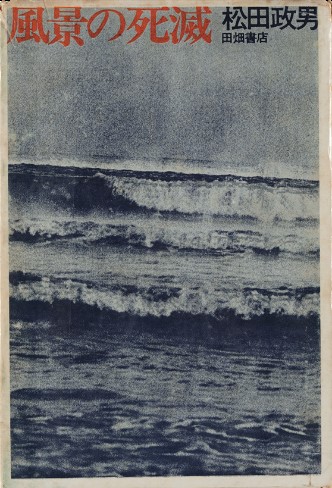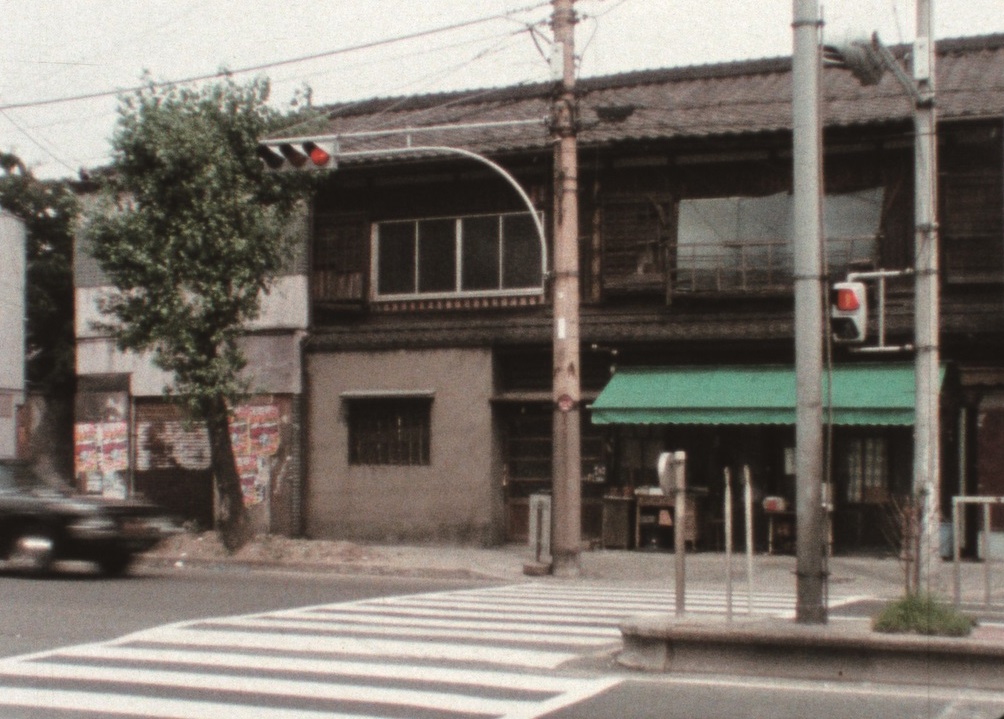‘In the autumn of last year, there were four cases of homicide committed in four cities using the same handgun. This spring, a 19-year-old man was arrested. He became known as “the handgun serial killer”.’ So begins Adachi Masao’s A.K.A. Serial Killer (1969), an experimental documentary that retraces the steps of Norio Nagayama, arrested in Tokyo on 7 April, 1969. Linguistic narration is otherwise scarce in the film, restricted to a handful of isolated statements supplying biographical details in a matter-of-fact voiceover. In place of conventional plot and character, the film offers a cascade of landscape images shown without commentary, accompanied by a careening free jazz soundtrack. Crisscrossing Japan, Adachi uses long takes to capture the locations of Nagayama’s life, from his childhood in Tōhoku’s Aomori Prefecture, a move to Tokyo as part of a mass-hiring initiative at age 15, and finally a disaffected drift across the country that culminated in murder. Trains, highways, ships, streets: whether desolate or crowded with people, these images are haunted by the troubled young man who perhaps once passed through them. What relation exists between Nagayama’s deeds and these impersonal spaces? Why tell his story in this way?

A.K.A. Serial Killer is the central work in ‘After the Landscape Theory’, on view from 11 August to 5 November at Tokyo’s Photographic Art Museum. Curated by Tasaka Hiroko in collaboration with film scholar Hirasawa Go, this fascinating presentation of moving images, photographs and documents situates Adachi’s film as a key node within a diffuse, multi-faceted engagement with landscape in lens-based Japanese art from 1968 to the present. At the entrance of the exhibition is a copy of The Extinction of Landscape (1971), an essay collection by Matsuda Masao, a film critic who collaborated on the production of A.K.A. Serial Killer and was a central figure in the articulation of fûkeiron, or ‘landscape theory’. Resolutely rejecting the idea of landscape as a pictorial form devoted to the contemplation of natural beauty and severing any connection it might have to nationalist sentiment, this discourse posited that the power of the state and of capital can be rendered visible in commonplace images of the built environment. It recognized that power is everywhere: not only in spectacular moments of violence, as when police clash with protesters, but in everyday life. Forces of domination are present in transportation infrastructures and norms of bodily comportment, in the ways cities are constructed and local specificities effaced. So often this is overlooked, naturalized. But when caught on film, the petrified surfaces of the world can be defamiliarized and opened to scrutiny.

Matsuda’s thinking took shape during a period of tremendous economic growth and social tumult, in the twilight of the so-called ‘season of politics’ of the late 1960s. It was a time when anti-authoritarian sentiment ran high in Japan – whether in university struggles, protests against the renewal of the United States-Japan Security Treaty (Anpo), or the conflicts surrounding the construction of the Narita International Airport at Sanrizuka. It was also when, as Hirasawa puts it in the exhibition catalogue, ‘the entire Japanese archipelago was being transformed into one gigantic metropolis’, with intense development and new transport links eroding the distinction between city and countryside. The turn to landscape in A.K.A. Serial Killer was, then, a way of placing Nagayama’s killing spree within the larger frame of these social transformations rather than seeking individual, psychological explanations for the working-class teenager’s crimes. As Matsuda wrote of the film, ‘We became very conscious of that very landscape as hostile “authority” itself. It is very likely that Nagayama shot bullets to tear apart the landscape. State power recklessly cuts through the landscape to clear the way, for instance, for the Tomei Freeway. As we enjoy a pleasant drive on that highway, at that very moment the landscape possesses us, and “authority” entraps us.’ Looking at the built environment entailed turning one’s back on media spectacle to mount a critique of capitalist modernity through the typically spectacular and eminently modern art of the cinema. It meant producing a counter-image, a counter-cartography.
Following the initial display of Matsuda’s book, ‘After the Landscape Theory’ pivots to the present. This reverse-chronological organization has the felicitous effect of loosening the hold of historical material over the interpretation of the contemporary works. The notion of being ‘after’ the landscape theory has two possible implications: the simple fact of coming later, or a more direct relation, be it of homage, imitation or critique, as in the convention of titling a work as ‘after’ the style of a master. The curatorial decision of presenting more recent works first encourages the former approach, avoiding notions of origin and derivation, and circumventing claims to influence that may be tenuous. The presence of Sasaoka Keiko’s photographic series PARK CITY (2001–) in the exhibition’s first room is striking in this regard, as these images of Hiroshima challenge the conceptions of visibility and legibility upon which landscape theory as deployed in A.K.A. Serial Killer depends. The series title, which refers to the Peace Memorial Park, places Sasaoka’s images unmistakably in the shadow of nuclear aggression. Eight photographs of exterior spaces made between 2001 and 2009 are so dark that the distant bodies within them are scarcely discernible. Blackness floods these frames, with the white socks of uniformed schoolgirls in one picture dotting the obscurity like beacons. Elsewhere, Sasaoka shoots plain streetcorners and the interiors of the Peace Memorial Museum. Across these different approaches, she confronts the limits of what can be seen of history’s wreckage, as if to echo the famous line from Alain Resnais’s 1959 film: ‘Tu n’as rien vu à Hiroshima’. Where A.K.A. Serial Killer considered how one might produce knowledge of a traumatic event, Sasaoka’s landscapes evoke muteness and unknowing. They hint at the possibility that images of the built environment might conceal as much as or more than they reveal. Theories, after all, are not facts; they are liable to fall short of their explanatory aims, and landscape theory is no exception.

Endo Maiko’s X (2022) and Takashi Toshiko’s 12-part Itami series (2005–10) are both serial moving-image works that approach landscape in a distinctly personal register. Made during the pandemic as an online project for the 14th Yebisu International Festival for Art and Alternative Visions, X was initially updated with new footage each day, producing an unfolding chronicle of the artist’s life. Itami similarly embeds the production of images in quotidian experience, such that the landscape is aligned with habit and intimacy, while the changing seasons provide a means of marking time. Such emphatically subjective approaches contrast sharply with not only Adachi’s film but also with the rule-based form of Imai Norio’s 8mm work Abenosuji (1977). An artist previously associated with the Gutai group, Imai filmed a series of traffic lights as they changed from red to green in a neighbourhood of Osaka. By allowing the presence of red lights to dictate where and when to make an image, he mitigates intentionality. This constraint intensifies the presence of contingency within the work, since all else that might appear in the frame besides the artist’s privileged motif is left to chance. Notably, traffic lights are responsible for regulating the movement of the masses at specified intervals; they tell Imai when to stop and film, just as they tell everyone when to stop and go. The concern with how social control manifests itself in urban space that so deeply marks A.K.A. Serial Killer resurfaces here in altered guise, as part of the relinquishing of authorial agency that is a hallmark of some strains of conceptual art.

A pristine 4K projection of A.K.A. Serial Killer leads to the exhibition’s final room, which presents an array of documents, photographs and film clips from when landscape theory first took hold – including Nagayama’s handwritten journal and a copy of the book, Tears of Ignorance, that he published from prison in 1971. Rather than shore up Adachi’s film as an origin point, this room emphasizes that the discourse on landscape lacks a single authoritative formulation; it was a dispersed and contradictory debate occurring across diverse films and publications. On display are a trailer and stills from Oshima Nagisa’s The Man Who Left His Will on Film (1970), in which an activist filmmaker who is being chased by the police jumps to his death. The ‘will’ he leaves on film depicts the cityscapes of Tokyo; his friends wander the metropolis in search of those same locations, as if in search of their elusive meaning. Since A.K.A. Serial Killer was not released until 1975, it was Oshima’s film – originally titled ‘Tokyo Landscape War’ – that was initially taken to be exemplary of landscape theory; meanwhile, Matsuda first used the term in relation to the pink filmmaking of Wakamatsu Koji, also present here in the form of excerpts and stills. In 1971, Adachi and Wakamatsu went to Beirut to make Red Army/P.F.L.P.: Declaration of World War, which marries the strategies of A.K.A. Serial Killer with the agitprop newsreel, depicting Palestinian fedayeen and members of the Japanese Red Army amidst landscape images. Three years later, Adachi would leave Japan to join the struggle in Palestine, abandoning filmmaking for nearly three decades.
Standing in this final room, it is possible to glimpse Sasaoka’s PARK CITY photographs back at the start: an architectural loop linking past to present. Why revisit all this material today? For a start because, as the exhibition demonstrates, the bond between landscape and power endures as a concern in artistic practice. In the catalogue, Hirasawa notes that, ‘Since the turn of the 21st century, a re-evaluation of landscape theory has taken place internationally, and it is likely not perceived as a specifically Japanese discourse.’ If it ever was: a programme of film screenings accompanying the exhibition gestures to the longstanding interest in landscape on the international left through the inclusion of works made between 1969 and 1981 by the Dziga Vertov Group, Jean-Luc Godard/Anne-Marie Miéville and Danièle Huillet/Jean-Marie Straub. Yet Hirasawa is correct in emphasizing contemporaneity. Today, landscape films comprise a vital current on the global circuit of festivals and biennials and, as a corollary, historical works of this kind have been the subject of renewed interest. Sometimes the connection to this past work is explicit: for instance, French-American artist Éric Baudelaire has produced a trilogy of films made with and ‘after’ Adachi, culminating in Also Known as Jihadi (2017). Meanwhile, the looser notion of coming after encompasses an avalanche of work. Whether in relation to concerns with climate, ecology and extractionism, out of a desire to move away from anthropocentrism, or as part of an effort to unearth traces of marginalized histories, landscape films have proliferated. As critic Leo Goldsmith has proposed, they ‘persist at a significant moment…in which the planet’s physical spaces are subject to increased quantification and abstraction on the one hand, and transformations to its geography accelerated by capitalism-driven human activity on the other’.
The present context is different to that which fuelled the debates in 1960s Japan, but there are affinities. Although, as works by Endo and Takashi show, landscape films can be tethered to first-person expression, their contemporary manifestations generally seek to transcend human perspectives and temporalities. The durational work of James Benning or Nikolaus Geyrhalter, for instance, is best understood as a response to crisis – to a ruined world in which ‘nature’ is a chimera. These are films for a time when anthropogenic changes to the environment are violent and ubiquitous, when rampant individualism must be refused, and when structural diagnoses are needed. Whether or not landscape theory produces the knowledge it promises remains an open question. What is certain is that it endures as a resource for filmmakers who seek to contest their present and, in turn, as a provocation for spectators for whom cinema is not only aesthetic but political and epistemological.
Read on: Jeremy Adelman, ‘The End of Landscape?’ NLR 126.